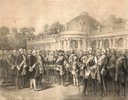
"Gustav, Count of Schlabrendorf (22 March 1750 – 21 August 1824), described in various sources as a "citizen of the world" ("Weltbürger"), was a political author and an enlightenment thinker. During or shortly before the first part of 1789 he relocated to Paris from where he enjoyed a ringside seat for the unfolding phases of the French Revolution which, initially, he enthusiastically supported. He backed the revolutionary precepts of "Liberty, Equality and Brotherhood". He soon had reason to become mistrustful of the revolution´s radicalisation, however, and during the "Terror" ("Terreur") period spent more than 17 months in prison, avoiding a terminal rendezvous with the guillotine only through an administrative oversight. He subsequently wrote several critical works about Napoléon Bonaparte. It was a reflection of his increasingly idiosyncratic lifestyle that by the 1820s he was becoming known as "The Hermit of Paris" (or, in certain more scholarly contemporary sources, "Eremita Parisiensis"): he was happy to endorse the soubriquet, on occasion using it to describe himself." - (en.wikipedia.org 08.11.2019)
 )
)